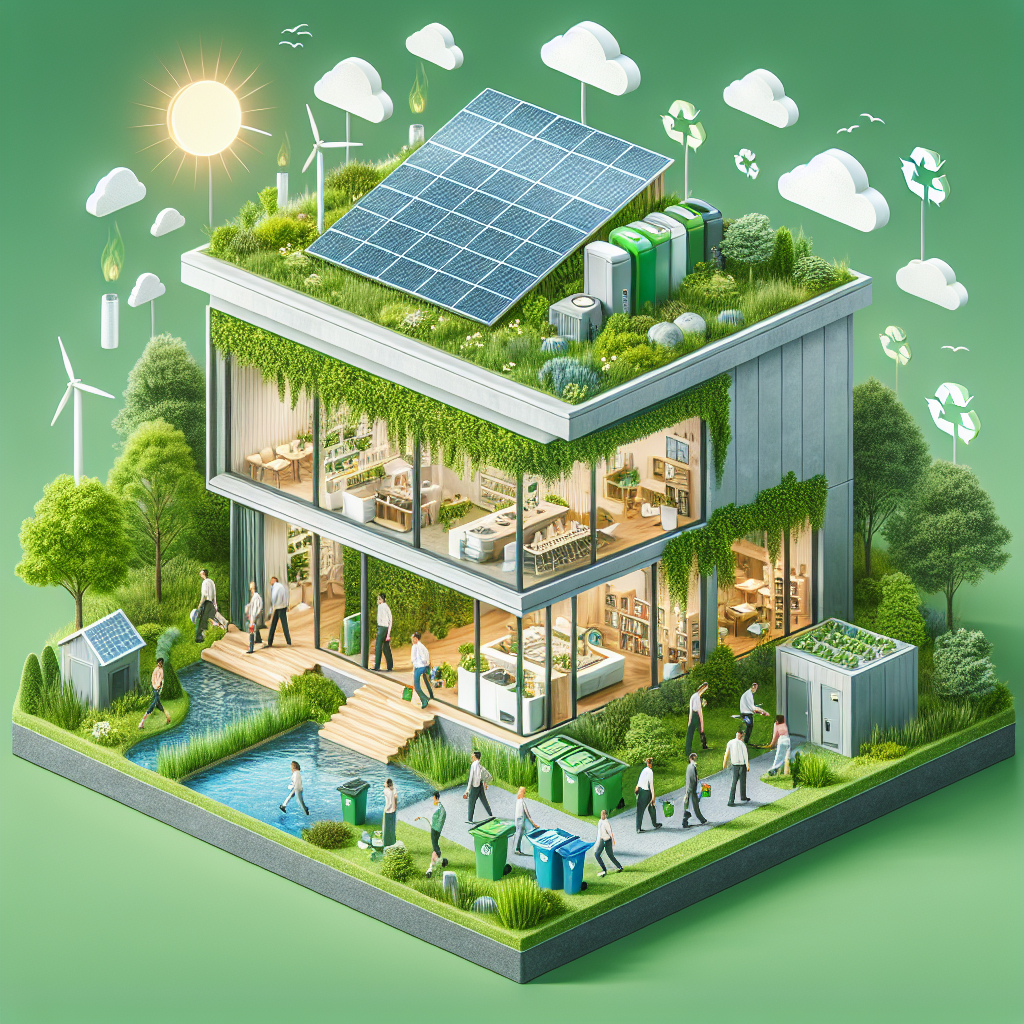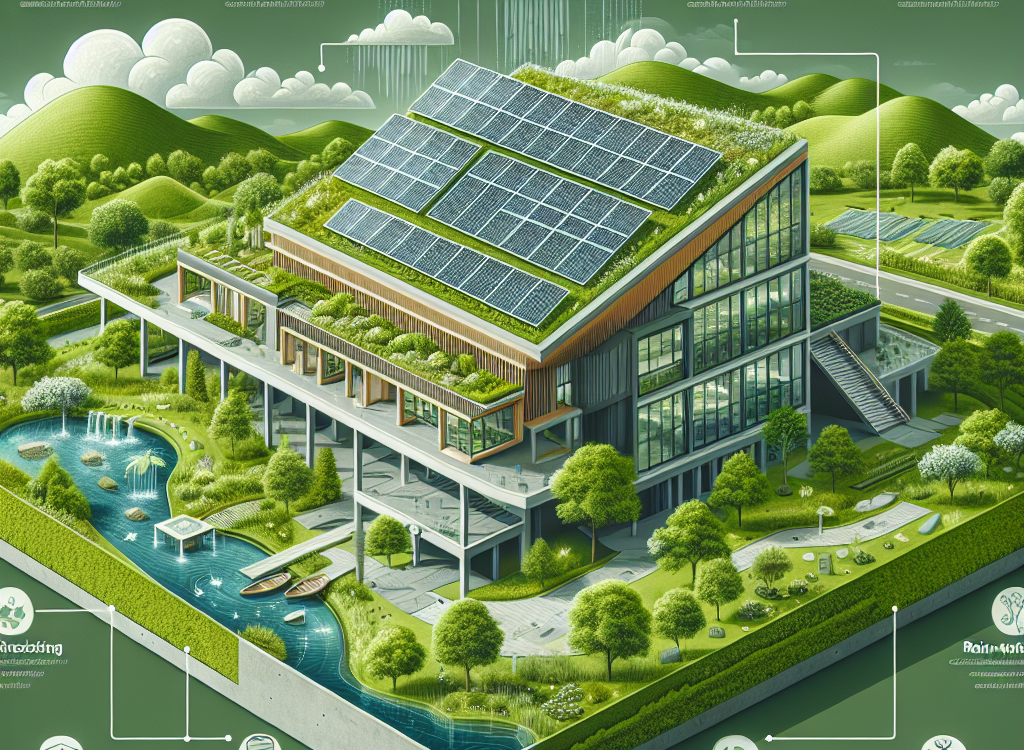What To Know
- Benefits of Green Building Technology in Sustainable ConstructionGreen building technology is a rapidly growing field that focuses on creating structures that are environmentally friendly and sustainable.
- From reducing the negative impact on the environment to improving energy efficiency, indoor air quality, and water conservation, green buildings are designed to be environmentally friendly and promote a healthier and more sustainable way of living.
Benefits of Green Building Technology in Sustainable Construction
Green building technology is a rapidly growing field that focuses on creating structures that are environmentally friendly and sustainable. It encompasses a wide range of practices and techniques that aim to minimize the negative impact of construction on the environment. From the materials used to the design and operation of the building, every aspect is carefully considered to ensure that it aligns with the principles of sustainability.
One of the key benefits of green building technology is its positive impact on the environment. Traditional construction methods often result in significant waste and pollution. Green building, on the other hand, aims to reduce waste and minimize the use of non-renewable resources. This is achieved through the use of sustainable materials, such as recycled or locally sourced materials, and the implementation of energy-efficient systems.
Energy efficiency is another major advantage of green building technology. Buildings are responsible for a significant portion of energy consumption and greenhouse gas emissions. Green buildings are designed to be highly energy-efficient, using techniques such as proper insulation, efficient heating and cooling systems, and the use of renewable energy sources. This not only reduces the carbon footprint of the building but also results in significant cost savings for the occupants.
Indoor air quality is another important consideration in green building technology. Traditional buildings often have poor indoor air quality due to the use of toxic materials and inadequate ventilation. Green buildings, on the other hand, prioritize the use of non-toxic materials and incorporate proper ventilation systems to ensure a healthy indoor environment. This has been shown to improve the health and well-being of occupants, leading to increased productivity and reduced absenteeism.
Water conservation is also a key aspect of green building technology. Traditional buildings often waste a significant amount of water through inefficient plumbing systems and landscaping practices. Green buildings, on the other hand, incorporate water-saving fixtures and landscaping techniques, such as rainwater harvesting and the use of native plants that require less water. This not only reduces water consumption but also helps to alleviate the strain on local water resources.
In addition to the environmental and health benefits, green building technology also has economic advantages. Green buildings are often more durable and require less maintenance than traditional buildings. They also have lower operating costs due to their energy-efficient design, resulting in long-term cost savings for the owners. Furthermore, green buildings are in high demand, with many businesses and individuals actively seeking out sustainable and environmentally friendly spaces. This can lead to increased property value and marketability.
In conclusion, green building technology offers numerous benefits in sustainable construction. From reducing the negative impact on the environment to improving energy efficiency, indoor air quality, and water conservation, green buildings are designed to be environmentally friendly and promote a healthier and more sustainable way of living. Additionally, green buildings offer economic advantages, such as lower operating costs and increased property value. As the demand for sustainable construction continues to grow, green building technology will play a crucial role in shaping the future of the construction industry.
Exploring the Key Principles of Green Building Technology

Green building technology is a rapidly growing field that focuses on creating sustainable and environmentally friendly structures. It encompasses a wide range of practices and techniques that aim to minimize the negative impact of construction on the environment. In this article, we will explore the key principles of green building technology and discuss its importance in today’s world.
One of the fundamental principles of green building technology is energy efficiency. Buildings are responsible for a significant portion of energy consumption and greenhouse gas emissions. By implementing energy-efficient measures, such as using insulation materials, installing energy-efficient appliances, and utilizing renewable energy sources, green buildings can significantly reduce their energy consumption and carbon footprint.
Another important principle of green building technology is water conservation. Water scarcity is a growing concern in many parts of the world, and buildings are major consumers of water. Green buildings incorporate various water-saving features, such as low-flow fixtures, rainwater harvesting systems, and graywater recycling systems. These measures help reduce water consumption and alleviate the strain on water resources.
Waste reduction and recycling are also key principles of green building technology. Construction and demolition waste contribute to a significant amount of landfill waste. Green buildings aim to minimize waste generation by using sustainable materials, implementing efficient construction practices, and promoting recycling and reuse of materials. By reducing waste, green buildings not only help protect the environment but also save valuable resources.
Indoor environmental quality is another crucial aspect of green building technology. Traditional buildings often have poor indoor air quality due to inadequate ventilation, the use of toxic materials, and the accumulation of pollutants. Green buildings prioritize the health and well-being of occupants by ensuring proper ventilation, using non-toxic materials, and incorporating natural lighting and indoor plants. These measures create a healthier and more comfortable indoor environment.
The use of sustainable materials is a cornerstone of green building technology. Traditional construction materials, such as concrete and steel, have a significant environmental impact due to their extraction, manufacturing, and transportation processes. Green buildings utilize sustainable materials, such as recycled content, rapidly renewable resources, and locally sourced materials. By choosing sustainable materials, green buildings reduce their carbon footprint and promote the development of a more sustainable construction industry.
Lastly, green building technology emphasizes the importance of site selection and design. Green buildings are designed to harmonize with their surroundings and minimize their impact on the natural environment. They take into account factors such as site orientation, landscaping, and stormwater management to create a sustainable and aesthetically pleasing built environment.
In conclusion, green building technology encompasses a range of principles and practices that aim to create sustainable and environmentally friendly structures. By focusing on energy efficiency, water conservation, waste reduction, indoor environmental quality, the use of sustainable materials, and thoughtful site selection and design, green buildings minimize their negative impact on the environment and promote a more sustainable future. As the world faces increasing environmental challenges, the importance of green building technology cannot be overstated. It is a crucial tool in mitigating climate change, conserving resources, and creating healthier and more sustainable communities.
The Role of Green Building Technology in Reducing Environmental Impact
Green building technology is a rapidly growing field that aims to reduce the environmental impact of buildings and promote sustainable practices. With the increasing concern about climate change and the need to conserve resources, green building technology has become an essential tool in the construction industry. This article will explore the role of green building technology in reducing environmental impact and why it is crucial for a sustainable future.
One of the primary goals of green building technology is to minimize the use of non-renewable resources. Traditional construction methods often rely on materials that are harmful to the environment, such as concrete and steel. Green building technology, on the other hand, focuses on using sustainable materials that have a lower carbon footprint. For example, instead of using concrete, builders can opt for materials like bamboo or recycled wood, which are renewable and have a lower environmental impact.
In addition to using sustainable materials, green building technology also emphasizes energy efficiency. Buildings are responsible for a significant portion of energy consumption and greenhouse gas emissions. By incorporating energy-efficient features, such as solar panels, efficient insulation, and LED lighting, green buildings can significantly reduce their energy consumption and carbon footprint. These energy-saving measures not only benefit the environment but also result in cost savings for the building owners in the long run.
Water conservation is another crucial aspect of green building technology. Traditional buildings often waste a significant amount of water through inefficient plumbing systems and landscaping practices. Green buildings, on the other hand, incorporate water-saving fixtures, such as low-flow toilets and faucets, as well as efficient irrigation systems. These measures help reduce water consumption and promote responsible water management.
Furthermore, green building technology also focuses on improving indoor air quality. Traditional buildings can have poor ventilation systems and use materials that release harmful chemicals into the air, leading to health issues for occupants. Green buildings prioritize the use of non-toxic materials and incorporate proper ventilation systems to ensure a healthy indoor environment. This not only benefits the occupants but also reduces the overall environmental impact of the building.
The role of green building technology extends beyond the construction phase. It also emphasizes the importance of sustainable building operations and maintenance. Green buildings often implement strategies to reduce waste generation, such as recycling programs and efficient waste management systems. Additionally, they promote the use of renewable energy sources for ongoing operations, such as geothermal heating and cooling systems. By adopting sustainable practices throughout the building’s lifecycle, green building technology ensures a long-term positive impact on the environment.
In conclusion, green building technology plays a crucial role in reducing the environmental impact of buildings. By using sustainable materials, promoting energy efficiency, conserving water, improving indoor air quality, and implementing sustainable building operations, green buildings contribute to a more sustainable future. As the world continues to grapple with the challenges of climate change and resource depletion, the adoption of green building technology becomes increasingly important. It is not only a responsible choice but also a necessary step towards creating a more sustainable and resilient built environment.
